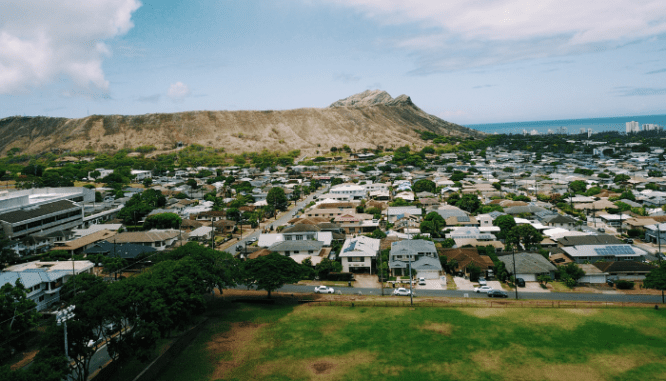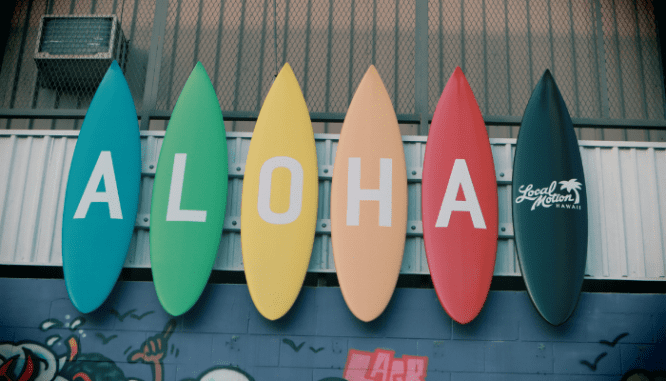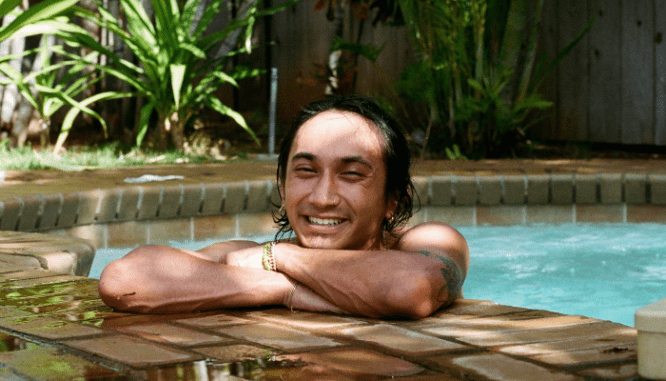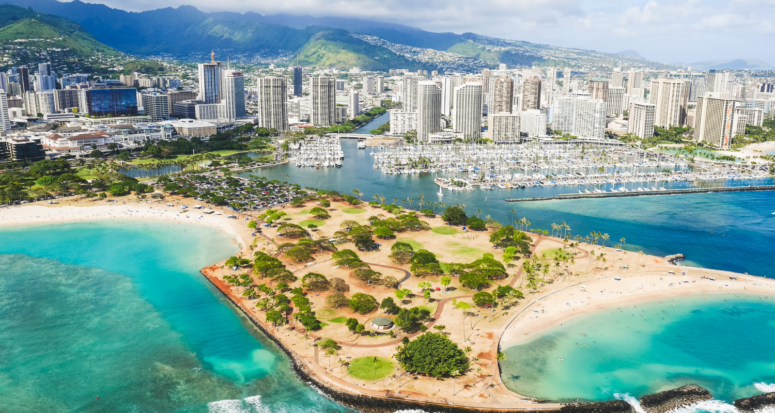How to Buy a house in Honolulu: City Living in the Aloha State
- Published on
- 7 min read
-
 Emily Eddy Contributing AuthorClose
Emily Eddy Contributing AuthorClose Emily Eddy Contributing Author
Emily Eddy Contributing AuthorEmily Eddy is a writer and art curator based in Chicago. Emily has been interested in real estate since a young age, as she grew up helping her mom with home renovations in her hometown of Portland, Oregon. Emily resides in a live-work loft in the Wicker Park neighborhood where she operates a "microcinema"; an apartment gallery specific to exhibiting experimental film. Emily and her cat, Clark Gable, spend their days writing, watching movies, gardening, and of course, binging HGTV.
If you’re looking for a new home in Honolulu, you must be excited to find your little piece of paradise, while keeping all the perks and conveniences of city living.
Buying a home off the mainland can seem like a daunting task, and in many ways, it will be very different than purchasing a home in less humid American cities — the tropical climate comes with some challenges including mold, termites, and building-permit costs. Beyond pest and home inspections, it is important to consider the fast-paced island housing market in Honolulu: The median home price is higher than on the mainland, and experts recommend that buyers prepare cash offers to stay competitive.
But don’t worry, you’re in the right place! We’ve learned all the tips and tricks you’ll need from Hawaiian real estate expert Dan Ihara to find your Hawaiian home, and we’ve researched some of Honolulu’s favorite neighborhoods to purchase homes in — from luxury estates, to single-family starter homes, to modern condos. We’ll teach you what types of homes Honolulu can offer you, how to avoid money-pit scenarios, and how to find the right home for your money in the city, based on feedback from our Honolulu experts. Now, let’s find your Aloha!

Budgeting for your home in the 808
If you are looking at real estate in Honolulu, chances are good that you’ve realized island life doesn’t come cheap. A single-family home costs a median of about a million or more (the median price for Honolulu single-family homes sold in February 2021 was $920,000), and if you’re looking at mid-city condos, you can expect to spend closer to $500,000 (the median price of condos sold in February 2021 was $455,000).
Land on the island of Oahu is what is valuable, not so much the house that’s on it. It’s a small island, so there is only so much land to go around, and it can be hard to come by. It is common for Hawaiians to keep a family home for generations, making sure that their children and grandchildren will be able to live on the island without breaking the bank.
Ihara says, “Land is super valuable; you can find a piece of dirt for $1.7 million, while the house built on it is only worth $200,000.” This makes purchasing condos or high-rise apartment units much more affordable than single-family homes, but if you buy land on the island, you will most certainly be making a remarkable investment.
Because Hawaiian land is so desirable, when it comes to making offers, cash is king (unfortunately, not as sweet for buyers as King’s Hawaiian Rolls). The market moves fast on Oahu — if a house sits on the market for more than a couple of weeks, that’s considered a long time without a sale. The median days on market for a single-family home in February 2021 was only 11, meaning it took just 11 days after listing the home for a buyer to make a winning offer.
This makes cash offers, or at least partial cash offers, much more appealing to sellers than buyers relying entirely on a mortgage to finance a house. If you don’t have the budget to buy a home in cash, Ihara says,
“You will need to bring at least a 25% to 30% down payment to the table in order to be considered a competitive buyer.”
Unfortunately, this means even median-income buyers struggle to purchase homes in Honolulu, which is why the median income of homebuyers in Honolulu is higher than buyers on the mainland. In 2013, a survey was conducted for new Hawaiian homebuyers stating that the median household income of buyers was $84,500 nationally and $124,500 in Honolulu.
Understanding island housing in Honolulu
Because land is precious in Honolulu, most housing structures on the island aren’t going to be new builds. Most single-family homes east of Pearl Harbor were built in the 1950s, ’60s, and ’70s, and the median age of Honolulu real estate was 46 years old in March 2019, while the mainland average was 37 years old. You can also expect that older homes will not have typical drywall and insulation; instead, you’ll have tongue-in-groove single-wall construction, meaning only wooden walls separating outdoors from inside.
Because of the tropical climate, houses aren’t likely to come equipped with the HVAC systems you might be used to on the mainland. To deal with the heat, most homes use split A/C systems, and if you want to upgrade to central air, you might need an expensive permit for renovations. Building permits, and even renovation permits, can be costly in Honolulu (the bare minimum permit fee is $18 per every $500 spent on repair and this includes anything from building a new home to installing a new faucet), so it is best to pick a home that doesn’t need further work, unless you have the budget for permitting.
Basements and attics are not typical in Honolulu homes; most homes are built “post and pier,” meaning they are set on posts above the soil, with crawl spaces underneath. This is because most of the island’s homes are built on adobe soil, which expands and contracts in response to the weather. When it rains, the soil expands, and in the summer dryness, it contracts, so homes are built slightly off the ground to avoid foundation issues. Because of this, it is highly recommended that you get a foundation assessment before purchasing.
Avoiding a money pit in paradise
When buying any new home, thorough inspections are always a necessary step, and this is no different when finding your Aloha address. However, there are some specific things to look out for in conducting inspections in Hawaii.
According to Oscar Libed, Owner of Inspect Hawaii, LLC, homebuyers and sellers must be careful when choosing a home inspector. Since Hawaii does not regulate home inspectors, anybody can call themselves a “home inspector” and they are not bound by any standards of practice, including a code of ethics.
The home inspector should at least be a member of one of the two nationwide established home inspector industry trade associations: the American Society of Home Inspectors (ASHI) or the National Association of Certified Home Inspectors (NACHI).
Also, be careful when choosing a home inspector based on price alone. Libed wisely states, “To quote Ben Franklin, The bitterness of poor quality remains long after the sweetness of low price is forgotten.’ Always get the best value for the money spent versus the cheapest cost.”
Due to the tropical environment, experts recommend getting a mold inspection no matter where you are buying, and especially if you are buying in one of Oahu’s valleys (like Honolulu), where moisture can be trapped more easily.
Flooding can be a big issue in Hawaii, but luckily there are easily accessible maps of FEMA floodplains both for Honolulu and the rest of the island. Although your new Hawaiian dream house is located in the middle of the Pacific Ocean, flooding mainly occurs due to rainstorms on the island, so surprisingly, your home is more likely to flood if you live closer to a river than the beach. Flood insurance is not only recommended, but it’s really a necessity in a wet environment like Hawaii.
The big bad bug on the island is the termite, and due to the majority of housing in Honolulu being wood construction, a termite inspection is recommended for any home purchase.
Other recommended inspections before buying include a gas line inspection, A/C inspection if your home has central air, and a pool inspection for peace of mind when lounging poolside.
Another huge perk of island living is that many homes have photovoltaic solar energy panels installed for electricity, which is a big win for both the environment and your electricity bill. Ihara says this can make energy bills go from “$400 a month down to $18 a month.” That said, if your home is equipped with photovoltaic panels, you should absolutely get them inspected before purchasing.
Because of all the specific complications of buying on the island vs. the mainland, more than anything, it will be important to find a local real estate agent who’s intimately familiar with the Honolulu market. It will be best for you —and your bank account — to find a long-term local, someone whom you can trust to understand common issues with Hawaiian housing, the lay of the land, and the Aloha culture.

Settling into Aloha
Newcomers to island life need to understand that the culture is very different from mainland American cities. Ihara says: “It’s all about Aloha.”
The culture of “aloha” means more than both hello and goodbye; it evokes mutual respect for your neighbors and fellow Hawaiians. If you’re used to a fast-paced and aggressive city life, you’re in for a big change moving to Oahu. Island life moves slower, and you need to prepare to leave your big-city attitude behind.
For example, Ihara explains,
“If you’re merging, and you don’t wave ‘thank you’ to a car that lets you in, that’s considered rude.”
Also, be sure to leave your shoes at the door. Due to the influence of indigenous and Asian populations on the island, it is part of the Hawaiian lifestyle to keep your shoes off in the house, so kick them off before entering your new neighbor’s home.
As long as you are respectful and open to embracing the aloha culture, you shouldn’t have any problem fitting in as an island newcomer.
Mapping out Honolulu’s Neighborhoods
Besides being able to find delicious pineapple, loco moco, or poké anywhere in the city, the neighborhoods of Honolulu have a lot to offer both culturally and in terms of housing variety. Here are a few neighborhoods where you can find your version of island paradise.
Waikiki
Located in southwest Honolulu, Waikiki is a bustling area filled with beautiful hotels, ocean views, and great food.
Although Waikiki is the main tourist area of the city, it might be just what you’re looking for if you prefer condo life in the city. Condos in Waikiki don’t come cheap, but its proximity to high-end shopping, bars, restaurants, nightlife, and Waikiki Beach make it an appealing area to call home. The average selling price in 2020 was $450,000 for a condo near Waikiki Beach, with COA (condo-owners association) fees running anywhere between $100 and $3,000 a month, depending on the building’s amenities. If you’re looking for a true “downtown” living experience in Hawaii, this might just be exactly what you’re after.
Kahala
If you’re looking for true island luxury, go no further than the Kahala neighborhood. Located just east of Waikiki near Diamond Head Beach Park, Kahala feels very much like the Beverly Hills of Hawaii, boasting luxury homes, a golf course and spa at the world-class Kahala Hotel & Resort, lavish Sunday brunch at Hoku’s or oceanside dinner at Hau Tree, and celebrity sightings on Kahala’s upscale private beaches.
Although the area feels fit for Hawaiian royalty, it is also home to Honolulu’s growing sustainable food movement, as the Kapiʻolani Community College (KCC) farmer’s market calls the Kahala neighborhood home. The KCC market is one of the largest local food and produce markets in Hawaii, making the Kahala neighborhood a destination for foodies and farmers alike. You are unlikely to find a home for less than $1 million here, with the median list price being $2.75 million in 2019.
Kaimuki
If you’re looking for a quaint neighborhood with great coffee shops such as Coffee Talk, locally owned stores like Hungry Ear Records, and locally-loved restaurants like Big City Diner, Kaimuki is the place for you. Kaimuki is a mostly residential neighborhood, and it has a very livable feel for anyone who wants a more authentic local experience in moving to the island.
The neighborhood also boasts two great parks to bring your furry friend, “Christmas Tree Park” as the locals call Pu’u O Kaimuki Park, and Diamond Head Bark Park for fun with your tropical pup. You will find many picturesque homes in this neighborhood with a median price of $1.43 million.
Kalama Valley
One of the most popular places to find homes for less than $1 million is Kalama Valley, about a 30-minute commute from Downtown Honolulu, giving the area a more suburban feel that is still close to the bustle of downtown.
Kalama Valley is a residential area that is still close to beaches like Sandy and Makapuu, making it a great area to find your perfect Hawaiian family home. Single-family homes in this area are also a bit bigger than other areas of the island, most with three to four bedrooms on 5,000-to-7,000-square-foot lots.
In Oahu’s valleys, mold can be more of an issue than in the higher-elevation areas, so be sure to get a mold inspection if you are looking in the Kalama Valley area.
Mariner’s Valley
Mariner’s Valley has a similar suburban feel to Kalama Valley, but with more of a more historical vibe. Located in Hawaii Kai (East Oahu), homes in Mariner’s Valley were built between 1969 and 1972, giving homes an interesting mid-century-modern feel, though most homes have been renovated to include updated appliances.
Because of the zoning and permitting rules on Oahu, be advised that if you buy a home that has not been renovated, desired renovations could be costly. Check with your real estate agent to make sure you can renovate without an expensive permit.
Mariner’s Valley and Kalama Valley are great areas for growing families, and the Hawaii Kai ZIP code has GreatSchools ratings from 7/10 to 10/10.
Kamiloiki
Kamiloiki is actually an addition of Mariner’s Valley, located in the back Northeast portion of the neighborhood. Here you can find some newer builds, and you can actually see the dividing line between the pre-1987-built homes and the newer homes (built after 1991) starting at the beginning of Miloiki Street.
Some of the newer-build homes in the area are a little larger than others in Mariner’s Valley, with lot sizes between 9,000 and 13,000 square feet. If you’re looking for a newer house in a beautiful suburban area, Kamiloiki might be for you!

When to buy a house in Honolulu
Fortunately for sellers, because the market moves so quickly, there isn’t really a bad time to sell anywhere in Hawaii. Unfortunately for buyers, Hawaii is an almost perpetual seller’s market, meaning that buying below listing price or making concessions with a seller is very rare.
If you are looking to purchase a home below listing price, you will have to look specifically for homes that have been on the market for longer periods (in Hawaii, this only means about a month).
The glass-half-full look at the Hawaiian buyer’s market is, assuming that you have the funds to buy a house in Honolulu, there’s never a bad time to start living your Hawaiian dream.
Find a top buyer’s agent in Honolulu
You can start looking for your Honolulu home by talking to an agent who knows all about the area. A top buyer’s agent in Honolulu does almost twice as many deals as the average agent, and helps clients save significantly on their home purchase, which means more you can spend on renovations (or on poké). Best of luck with finding your island dream home!
Header Image Source: (Cosmin Serban / Unsplash)

